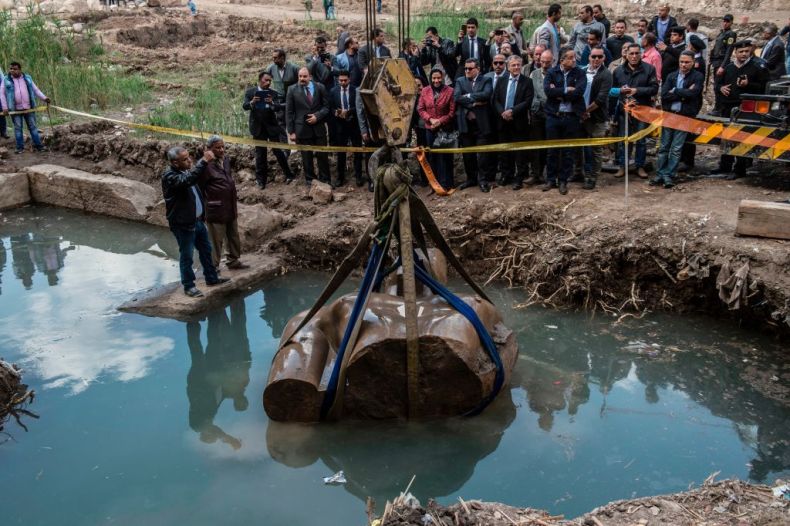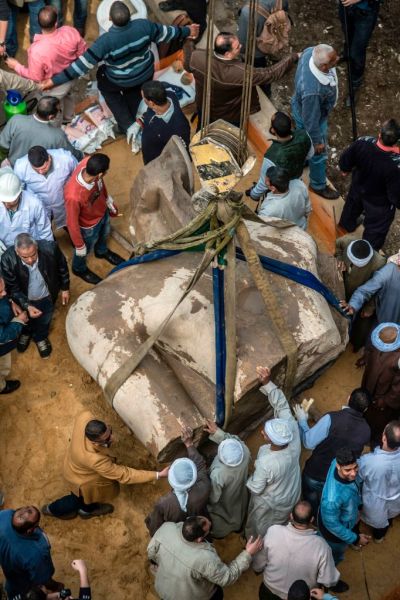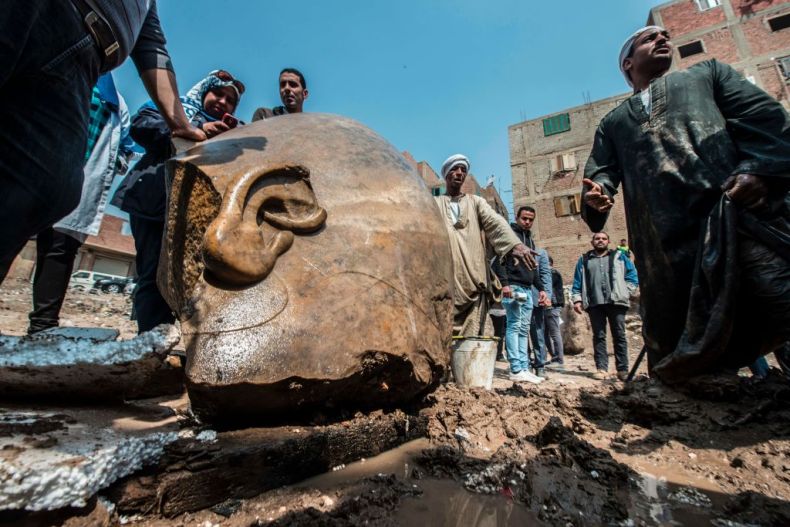Earlier this month, news of the discovery of a colossal statue of an ancient Egyptian king took the world by storm. Working deep in a water-logged pit, a joint team of Egyptian and German archaeologists discovered the eight metre-high colossus broken into two large pieces: a torso and lower part of the face, with a part of the pharaoh’s false beard present, and the top of its head, wearing a crown. These pieces have now been lifted to the surface, and taken for conservation at the Egyptian Museum in Cairo, where they will be temporarily displayed. Afterwards, the statue will be exhibited at the Grand Egyptian Museum, currently under construction at Giza and scheduled to open in 2018. Though early reports indicated that the quartzite colossus might have been erected under the famous King Ramesses II (c. 1279–1212 BC), it has since been shown to bear the name of King Psamtik I (c. 664–610 BC) of the Late Period – an arguably equally important pharaoh, though lacking the star power of the earlier, better known ruler.
The colossus was discovered in Matariya, a northeast suburb of Cairo. Now a densely packed area of apartment buildings, for thousands of years it was part of one of ancient Egypt’s greatest cities, better known today by its Greek name: Heliopolis, ‘City of the Sun’ (not to be confused with modern Heliopolis, a couple of kilometres to its east). From the beginning of Egyptian history, ancient Heliopolis was the main centre of Egypt’s sun cult, where priests worshipped the god Re, and developed myths proclaiming his temple to be built on the first land that rose from the floodwaters after creation. Ancient descriptions and depictions present it as a city of statues, obelisks (two of which are now in London and New York), sphinxes, shrines, large and elaborate temple complexes, housing, fields and farms, connected to the Nile by canal. It was a place of learning, where astronomical observations were made. Such was the city’s prestige that occasionally the office of high priest of Re was held by a royal prince.

KHALED DESOUKI/AFP/Getty Images
Despite its importance, the city fell into decline after the arrival of Alexander the Great in 332 BC, when it became a mine for building materials. Its finest statues and other monuments were carted off to other, more prosperous cities. Later, whatever stonework remained was used to help build Cairo, which slowly expanded over the years to engulf ancient Heliopolis. Consequently, Heliopolis’ remains are spread out beneath various heavily populated Cairo districts, accessible only in undeveloped patches, including at Matariya, where most of its major temples were probably situated.
Little survives, and despite investigations since the mid 19th century, much about ancient Heliopolis’ layout and temple complexes remains unknown. Indeed, tourists in search of the ancient city at Matariya are met only by a single obelisk from the reign of King Senwosret I (c. 1974–1929 BC), which stands alongside various assorted architectural remains and reconstructed tombs in a small, often overlooked open-air museum. This lies on the edge of Matariya’s wider archaeological site, encircled by apartment blocks and busy roads.
Ancient Heliopolis was excavated intermittently over the course of the 20th century, revealing pieces of royal colossi, statues of kings and courtiers, reliefs bearing inscriptions, tombs of high priests, and other assorted architectural remains from across Egyptian history, always in a fragmented state. In 2005, a jointly-run mission by Egypt’s Ministry of Antiquities and the University of Leipzig started excavating at Matariya, focusing their attention on the western part of the area; this had not previously been excavated, though 18th-century writers had noted the presence of large statuary. The team soon uncovered what seemed to be a temple courtyard from the time of Ramesses II, where fragmentary colossal and life-size statues once stood. Some of these statues were of Ramesses II himself, while others were of the earlier King Senwosret I, and had been moved there under Ramesses to adorn his courtyard. (Such finds connected with Ramesses in this area, as well as the pharaoh’s penchant for monumental works, is why the colossus was initially thought to date to his reign.)

KHALED DESOUKI/AFP/Getty Images
In the years since the 2011 revolution, due to the ensuing lack of security, the various surviving preserved patches of ancient Heliopolis fell victim to encroachment from illegal building work and rubbish dumping, in addition to the ongoing danger posed by the rising water table. One part was even turned into a football pitch. In 2013, Monica Hanna, founder of Egypt’s Heritage Task Force, raised awareness of ancient Heliopolis’ plight by organising volunteers and antiquities inspectors to clean up the accumulated garbage in the area of Arab el-Hisn – another Cairo district where a patch of ancient Heliopolis remains – and wrote about the threats facing the archaeological remains.
Since the recent return to stability, illegal site encroachment in the area has ceased, but waste dumping remains a problem. Legal building work, however, also poses a threat to the area’s slowly vanishing ancient heritage. In 2015, the joint Egyptian-German excavation team received an emergency grant to investigate a part of ancient Heliopolis that was to be officially redeveloped by the governorate into schools and youth clubs.

KHALED DESOUKI/AFP/Getty Images
The recently discovered colossus is a testament to the fame and architectural splendours of ancient Heliopolis – a city rich in history, with many secrets left to be uncovered. Though the discovery of the colossus is not too surprising, given the other finds made at Heliopolis over the past 150 years, it is encouraging to see it receive so much media attention (the presumed connection with Ramesses II no doubt helped). Not only does it add an extra clue to reconstructing the ancient city, but perhaps more importantly, by shedding a light on the remains of this much neglected site, the media can help bring its existence to a wider public.
Writing in the Daily News Egypt in 2013, Monica Hanna said that the best way to protect ancient Heliopolis would be to turn it into a tourist attraction and enhance the connection between it and the local community. Discoveries such as the colossus can help lead to such increased awareness. A thriving and expanded open-air museum – similar to that at nearby ancient Memphis, where coach-loads of visitors arrive each day to see Pharaonic statues – would be a boon for tourists and Matariya’s local community alike. It may have lost its headline-grabbing association with Ramesses II, and perhaps some of the media’s attention with it, but perhaps the colossus’ newfound star power can still make a difference. Perhaps its fame is a first step towards a better future for ancient Heliopolis.

Can a long-lost Egyptian colossus save ancient Heliopolis?
Egyptian workers pose next to an excavated statue, recently discovered by a team of German-Egyptian archeologists, in Cairo's Mattarya district on March 13, 2017. KHALED DESOUKI/AFP/Getty Images
Share
Earlier this month, news of the discovery of a colossal statue of an ancient Egyptian king took the world by storm. Working deep in a water-logged pit, a joint team of Egyptian and German archaeologists discovered the eight metre-high colossus broken into two large pieces: a torso and lower part of the face, with a part of the pharaoh’s false beard present, and the top of its head, wearing a crown. These pieces have now been lifted to the surface, and taken for conservation at the Egyptian Museum in Cairo, where they will be temporarily displayed. Afterwards, the statue will be exhibited at the Grand Egyptian Museum, currently under construction at Giza and scheduled to open in 2018. Though early reports indicated that the quartzite colossus might have been erected under the famous King Ramesses II (c. 1279–1212 BC), it has since been shown to bear the name of King Psamtik I (c. 664–610 BC) of the Late Period – an arguably equally important pharaoh, though lacking the star power of the earlier, better known ruler.
The colossus was discovered in Matariya, a northeast suburb of Cairo. Now a densely packed area of apartment buildings, for thousands of years it was part of one of ancient Egypt’s greatest cities, better known today by its Greek name: Heliopolis, ‘City of the Sun’ (not to be confused with modern Heliopolis, a couple of kilometres to its east). From the beginning of Egyptian history, ancient Heliopolis was the main centre of Egypt’s sun cult, where priests worshipped the god Re, and developed myths proclaiming his temple to be built on the first land that rose from the floodwaters after creation. Ancient descriptions and depictions present it as a city of statues, obelisks (two of which are now in London and New York), sphinxes, shrines, large and elaborate temple complexes, housing, fields and farms, connected to the Nile by canal. It was a place of learning, where astronomical observations were made. Such was the city’s prestige that occasionally the office of high priest of Re was held by a royal prince.
KHALED DESOUKI/AFP/Getty Images
Despite its importance, the city fell into decline after the arrival of Alexander the Great in 332 BC, when it became a mine for building materials. Its finest statues and other monuments were carted off to other, more prosperous cities. Later, whatever stonework remained was used to help build Cairo, which slowly expanded over the years to engulf ancient Heliopolis. Consequently, Heliopolis’ remains are spread out beneath various heavily populated Cairo districts, accessible only in undeveloped patches, including at Matariya, where most of its major temples were probably situated.
Little survives, and despite investigations since the mid 19th century, much about ancient Heliopolis’ layout and temple complexes remains unknown. Indeed, tourists in search of the ancient city at Matariya are met only by a single obelisk from the reign of King Senwosret I (c. 1974–1929 BC), which stands alongside various assorted architectural remains and reconstructed tombs in a small, often overlooked open-air museum. This lies on the edge of Matariya’s wider archaeological site, encircled by apartment blocks and busy roads.
Ancient Heliopolis was excavated intermittently over the course of the 20th century, revealing pieces of royal colossi, statues of kings and courtiers, reliefs bearing inscriptions, tombs of high priests, and other assorted architectural remains from across Egyptian history, always in a fragmented state. In 2005, a jointly-run mission by Egypt’s Ministry of Antiquities and the University of Leipzig started excavating at Matariya, focusing their attention on the western part of the area; this had not previously been excavated, though 18th-century writers had noted the presence of large statuary. The team soon uncovered what seemed to be a temple courtyard from the time of Ramesses II, where fragmentary colossal and life-size statues once stood. Some of these statues were of Ramesses II himself, while others were of the earlier King Senwosret I, and had been moved there under Ramesses to adorn his courtyard. (Such finds connected with Ramesses in this area, as well as the pharaoh’s penchant for monumental works, is why the colossus was initially thought to date to his reign.)
KHALED DESOUKI/AFP/Getty Images
In the years since the 2011 revolution, due to the ensuing lack of security, the various surviving preserved patches of ancient Heliopolis fell victim to encroachment from illegal building work and rubbish dumping, in addition to the ongoing danger posed by the rising water table. One part was even turned into a football pitch. In 2013, Monica Hanna, founder of Egypt’s Heritage Task Force, raised awareness of ancient Heliopolis’ plight by organising volunteers and antiquities inspectors to clean up the accumulated garbage in the area of Arab el-Hisn – another Cairo district where a patch of ancient Heliopolis remains – and wrote about the threats facing the archaeological remains.
Since the recent return to stability, illegal site encroachment in the area has ceased, but waste dumping remains a problem. Legal building work, however, also poses a threat to the area’s slowly vanishing ancient heritage. In 2015, the joint Egyptian-German excavation team received an emergency grant to investigate a part of ancient Heliopolis that was to be officially redeveloped by the governorate into schools and youth clubs.
KHALED DESOUKI/AFP/Getty Images
The recently discovered colossus is a testament to the fame and architectural splendours of ancient Heliopolis – a city rich in history, with many secrets left to be uncovered. Though the discovery of the colossus is not too surprising, given the other finds made at Heliopolis over the past 150 years, it is encouraging to see it receive so much media attention (the presumed connection with Ramesses II no doubt helped). Not only does it add an extra clue to reconstructing the ancient city, but perhaps more importantly, by shedding a light on the remains of this much neglected site, the media can help bring its existence to a wider public.
Writing in the Daily News Egypt in 2013, Monica Hanna said that the best way to protect ancient Heliopolis would be to turn it into a tourist attraction and enhance the connection between it and the local community. Discoveries such as the colossus can help lead to such increased awareness. A thriving and expanded open-air museum – similar to that at nearby ancient Memphis, where coach-loads of visitors arrive each day to see Pharaonic statues – would be a boon for tourists and Matariya’s local community alike. It may have lost its headline-grabbing association with Ramesses II, and perhaps some of the media’s attention with it, but perhaps the colossus’ newfound star power can still make a difference. Perhaps its fame is a first step towards a better future for ancient Heliopolis.
Unlimited access from just $16 every 3 months
Subscribe to get unlimited and exclusive access to the top art stories, interviews and exhibition reviews.
Share
Recommended for you
The artists who dine out on their reputation
Damien Hirst is by no means the first artist to have done a doodle for a restaurateur
The cultural and corporate icon that is Monarch of the Glen
Drinks company Diageo planned to sell the painting, but after public outcry it now seems likely to remain in Scotland after all
‘Hull can boast buildings of national significance’
The UK’s City of Culture is home to a selection of great public buildings – from a late gothic masterpiece, to a state of the art ‘subquarium’